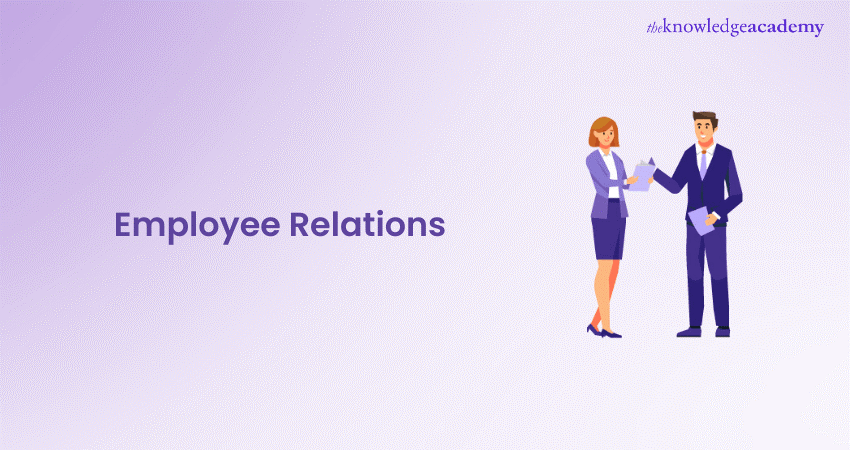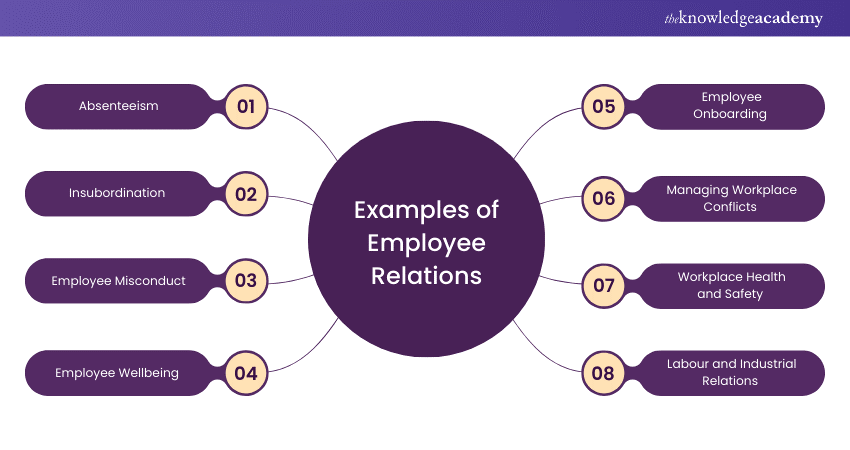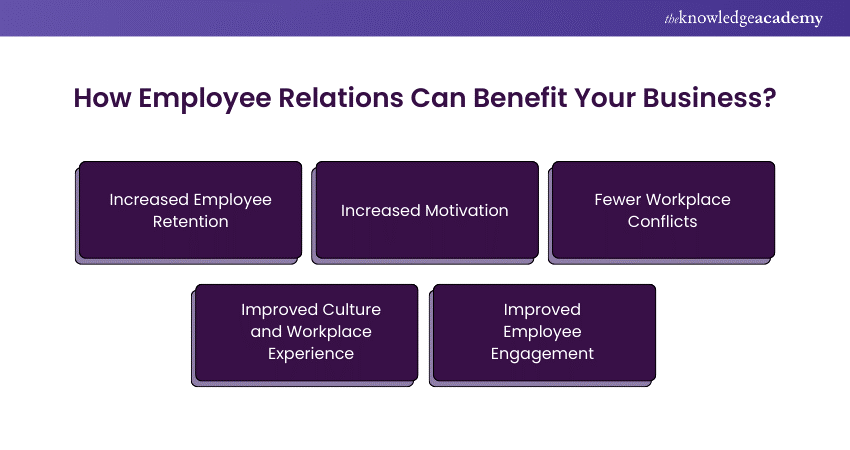We may not have the course you’re looking for. If you enquire or give us a call on 800969236 and speak to our training experts, we may still be able to help with your training requirements.
Training Outcomes Within Your Budget!
We ensure quality, budget-alignment, and timely delivery by our expert instructors.

Have you ever wondered what makes a workplace truly thrive? The answer often lies in Employee Relations. Picture a workplace where communication flows effortlessly, conflicts are resolved quickly, and employees are genuinely happy. This is the power of effective Employee Relations.
Wouldn’t you love to be part of a company where your contributions are recognised and your wellbeing is prioritised? Strong Employee Relations can lead to higher job satisfaction and increased loyalty.
Read this blog to transform your workplace by investing in Employee Relations strategies today. Discover how positive Employee Relations can create a more engaged and productive work environment.
Table of Contents
1) What is Employee Relations?
2) Why is Employee Relations Management Crucial?
3) Examples of Employee Relations
4) Approaches to Resolving Employee Relations Issues
5) Tips for Crafting an Effective Employee Relations Strategy
6) How Employee Relations Can Benefit Your Business?
7) How can Employee Relations be Managed?
8) Conclusion
What is Employee Relations?
Employee Relations (ER) is the relationships between employers and Employees, both individually and collectively. It includes contractual, physical, and emotional connections. Typically, the Human Resources department manages ER, implementing strategies and practices to maintain healthy employment relations.
Why is Employee Relations Management Crucial?
Positive relationships among colleagues and the leadership team are essential for effective teamwork. Proper relationship management fosters respect, collaboration, openness to new ideas, and seamless cooperation.
To maintain positive Employee Relations, organisations should view employees as key Stakeholders and contributors. This perspective encourages management to seek employee feedback, value their input, and consider the employee experience in business decisions.
Examples of Employee Relations
When organisations honour the rights and meet the expectations of their employees, Employee Relations issues are less likely to escalate. Prioritising ER involves integrating it throughout operations and the employee life cycle. Here are eight examples of various Employee Relations matters:

1) Absenteeism
Unplanned absences disrupt workflows and can lead to decreased productivity. An effective ER approach identifies the underlying causes of absenteeism, such as personal issues, health problems, or workplace dissatisfaction.
By addressing these causes through targeted employee support programs or by restructuring work procedures, organisations can reduce absenteeism and maintain smoother operations. This proactive approach not only helps in managing attendance but also enhances overall employee satisfaction and engagement.
2) Insubordination
Disrespect or refusal to follow directions undermines leadership. ER helps prevent this by setting behaviour expectations, providing communication training, and promoting a culture of teamwork and respect.
3) Employee Misconduct
Addressing harmful behaviour, from minor infractions to serious misconduct like harassment, is crucial. Effective ER sets clear policies, confidential reporting methods, and procedures for investigation and resolution.
4) Employee Wellbeing
Investing in employees’ wellbeing through assistance programs and flexible work arrangements demonstrates a commitment to their needs. These initiatives show the organisation’s dedication to valuing employees’ health and happiness, fostering a supportive work environment that leads to increased engagement and satisfaction.
5) Employee Onboarding
A thorough onboarding program ensures new hires feel welcome, informed, and ready to start. This sets a positive tone for the Employer-Employee Relationship.
6) Managing Workplace Conflicts
Conflict is common, with managers spending over 4 hours a week on it. Effective ER involves formal procedures and professionals to manage and resolve conflicts. This demonstrates the commitment to a healthy work environment.
7) Workplace Health and Safety
Ensuring physical and mental safety is critical. This includes implementing safety standards and fostering a supportive, stress-free environment, reinforced by educating employees about safety protocols.
8) Labour and Industrial Relations
The relationship between employers and unions is fundamental to Employee Relations. These interactions focus on negotiations, collective bargaining, and dispute resolution to ensure fair treatment and better working conditions.
Maintaining open communication channels between employers and unions can prevent misunderstandings. Constructive dialogue and transparency enhance labour relations and create a peaceful work environment.
Do you want to learn how to design and implement impactful employee training? Sign up for our Employee Training and Development Course today!
Approaches to Resolving Employee Relations Issues
Maintaining a positive relationship between employers and employees is necessary for a productive and harmonious workplace. Here are some key strategies to achieve this balance:
1) Develop an Employee Relations Strategy
An effective Employee Relations strategy balances the needs of both employers and employees. Employers seek productivity and performance, while employees desire acknowledgement and appreciation. A well-crafted strategy ensures both parties achieve their goals. Key Performance Indicators (KPIs) to include are:
1) Number of recognitions
2) Number of complaints
3) Complaint response time
4) Quarterly benefits and compensation data compared to competitors
5) Employee satisfaction
6) Employer performance
2) Actively Listen to Employee Feedback
Handling Employee Relations issues effectively starts with listening. Pay full attention to what employees are saying, both vocally and physically, before taking appropriate action. This approach helps in understanding the root cause of issues and addressing them effectively.
3) Educate and Communicate Effectively
Effectively educating and communicating with employees is essential for fostering positive relationships. It’s important to keep employees well-informed about rules and expectations. Consistency is crucial; granting privileges to some employees over others can result in dissatisfaction and disengagement.
4) Ensure Legal Compliance
Thorough documentation is crucial for effectively managing Employee Relations issues. Maintaining accurate legal and employee records is essential, particularly in the event of an employee lawsuit. These records provide a reliable reference for past actions and decisions, ensuring compliance with legal standards and supporting fair and consistent management practices.
Tips for Crafting an Effective Employee Relations Strategy
Every organisation should have a strategy for managing Employee Relations, recognising employees as valuable stakeholders in the company’s mission. Here are seven ways to optimise Employee Relations:
1) Understand the Psychological Contract
At the core of the employee-employer relationship is a social and psychological contract consisting of beliefs about reciprocal obligations. Employees often perceive that their organisation has failed to fulfil this contract. This leads to reduced trust, job satisfaction, intention to stay, sense of obligation, and performance. Understanding when these perceptions arise is crucial. There are two root causes of perceived breaches, which are:
1) Reneging: When an organisation recognises an obligation but fails to meet it, such as a recruiter promising a promotion within three years and not delivering.
2) Incongruence: When there is a misunderstanding about the existence or nature of an obligation, like a vague promise of quick promotions being interpreted as a guarantee.
To manage these effectively:
1) Keep Your Promises: Avoid overselling opportunities to prevent disappointment.
2) Communicate Clearly and Honestly: Address any inability to fulfil obligations promptly and transparently.
2) Foster Honest Communication
Honest and timely communication is the cornerstone of strong Employee Relations. Managers should regularly share organisational updates, promptly inform teams about changes, and create an environment where employees feel safe to voice their opinions.
Effective Communication is a two-way street. Providing opportunities for employee feedback is essential. Open communication channels and feedback systems help address employee concerns and build trust within the organisation.
3) Align with the Company’s Vision
Frequently share the organisation’s mission and vision, explaining how employees’ roles align with these goals. Also, inform them about the organisation’s values, plans, and challenges. Transparency and seeking employee input can motivate them to support the mission, making them feel part of something bigger.
4) Build Trust in Your Team
Refrain from micro-managing employees in your team/office. Instead, empower them to take charge of their work and make decisions independently. Cultivating a culture of trust significantly enhances employees’ perceptions of their employer. In high-trust companies, employees are more satisfied with their jobs, feel a stronger connection to the company’s purpose, and develop closer relationships with their coworkers.
Train Managers to clearly communicate expectations and find the right balance between providing guidance and granting autonomy.
5) Enhance Recognition and Appreciation
Steer clear of micro-managing employees and instead empower them to take ownership of their work and make decisions independently. This approach fosters a culture of trust, significantly enhancing employees’ perceptions of their employer.
In high-trust companies, employees are more satisfied with their jobs, feel a stronger connection to the company’s purpose, and build closer relationships with their coworkers. Train Managers to clearly convey expectations and strike a balance between providing guidance and granting autonomy.
6) Invest in Employee Development
Provide resources that benefit employees personally, such as learning and development programs, peer mentoring, and wellness initiatives. Offering flexibility for personal development and self-care shows that the company values individual growth and wellbeing. Allow employees to manage their own schedules to fit in learning and self-care activities.
7) Continuously Monitor Employee Relations
Throughout the employment relationship, various legal considerations must be addressed, including:
1) Wages and Overtime
2) Discrimination
3) Workplace Safety
4) Wrongful Termination
Employers must understand and comply with regulations, ensuring employees are informed about and receive their entitled rights and benefits.
Employees today are more empowered and knowledgeable about employment laws, which have increasingly favoured them over the past two decades. Consequently, employers need to exercise greater caution in their practices.
Learn motivational strategies to inspire and engage employees for enhanced productivity with our Employee Engagement Training – Join today!
How Employee Relations Can Benefit Your Business?
Employees are the essential cogs that keep a business running. Without a happy and motivated workforce, businesses struggle to function effectively. Healthy Employee Relations are key to a motivated workforce, bringing several benefits:

1) Increased Employee Retention: Positive Employee Relations reduce the likelihood of employees leaving their jobs or bosses. Improved ER can lead to better employee retention, as it’s often said that employees leave bosses, not jobs.
2) Increased Motivation: A positive relationship between the workforce and the employer can boost employees’ motivation to work harder and be more creative. When employees feel valued, and their relations with management are nurtured, motivation and productivity levels rise.
3) Fewer Workplace Conflicts: Poor Employee Relations management often leads to workplace conflicts. A strong HR strategy around ER can prevent conflicts, making the best resolution strategy one of prevention through positive Employee Relations.
4) Improved Culture and Workplace Experience: Workplace culture appeals significantly to job seekers. Enhancing the existing culture is a high priority, and a strong relationship with the workforce is a key driver for a positive workplace culture, making employees feel more comfortable at work and with management.
5) Improved Employee Engagement: Line Managers who are on the front line of communication with the workforce should be fully trained to handle employees’ concerns and mediate conflicts.
How can Employee Relations be Managed?
Despite the increased legal protections for employers and employees today, conflicts can still arise. It’s essential for businesses to proactively prevent conflicts and foster healthy employment relations to keep the workforce motivated. Here are some effective strategies:
1) Set Clear Company Goals and Visions: Clearly defined goals help employees understand what they are working towards and how they fit into the company’s overall vision.
2) Have a Transparent Employee Relations (ER) Policy: This policy should include the company’s mottos, ethos, values, guidelines, and rules. Including this policy in the employee handbook sets clear boundaries from the start.
3) Be Honest and Upfront with the Workforce: Communicate openly about any changes to job status, roles, or responsibilities. Regular communication and team updates are crucial.
4) Management Training in Employee Relations: Line Managers, who are on the front line of communication with the workforce, should be fully trained in handling employees’ concerns and mediating conflicts.
Understand how to satisfy your employees and create a positive work atmosphere with our Employee Engagement Training – Register today!
Conclusion
Employee Relations are important for a company’s success. Businesses can create a positive work environment by setting clear goals, maintaining transparency, and training management. This leads to higher retention, increased motivation, fewer conflicts, and a better workplace culture. Prioritising Employee Relations ensures a motivated and productive workforce.
Understand key principles of employee engagement and motivation with our Employee Relations Training – Sign up now!
Frequently Asked Questions

The five pillars are communication, trust, conflict resolution, recognition, and compliance. These elements ensure open dialogue, mutual respect, prompt issue resolution, employee appreciation, and adherence to workplace laws.

To maintain positive Employee Relations, focus on clear communication and recognise employee achievements. Resolve conflicts promptly, foster trust, and ensure fair treatment. Providing support, creating opportunities for growth, and involving employees in decision-making can also strengthen relations and boost satisfaction.

The Knowledge Academy takes global learning to new heights, offering over 30,000 online courses across 490+ locations in 220 countries. This expansive reach ensures accessibility and convenience for learners worldwide.
Alongside our diverse Online Course Catalogue, encompassing 19 major categories, we go the extra mile by providing a plethora of free educational Online Resources like News updates, Blogs, videos, webinars, and interview questions. Tailoring learning experiences further, professionals can maximise value with customisable Course Bundles of TKA.

The Knowledge Academy’s Knowledge Pass, a prepaid voucher, adds another layer of flexibility, allowing course bookings over a 12-month period. Join us on a journey where education knows no bounds.

The Knowledge Academy offers various People Management Courses, including Talent Acquisition Training, Talent Management Training and Successful People Management And Team Leadership Training. These courses cater to different skill levels, providing comprehensive insights into What is Talent Management.
Our HR Resources Blogs cover a range of topics related to Talent Acquisition, offering valuable resources, best practices, and industry insights. Whether you are a beginner or looking to advance your HR Skills, The Knowledge Academy's diverse courses and informative blogs have you covered.
Upcoming HR Resources – Learn about Human Resources Batches & Dates
Date
 Employee Relations Training
Employee Relations Training
Fri 28th Feb 2025
Fri 4th Apr 2025
Fri 27th Jun 2025
Fri 29th Aug 2025
Fri 24th Oct 2025
Fri 5th Dec 2025







 Top Rated Course
Top Rated Course



 If you wish to make any changes to your course, please
If you wish to make any changes to your course, please


